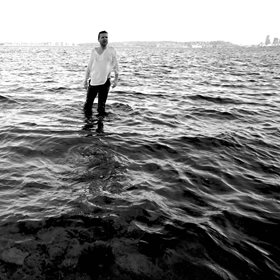.aspx) Ambitious for the audience
Ambitious for the audience
Tom Mùller by Sheridan Coleman
Speaking with Tom Mùller about his practice, whether touching on artwork, grants, audience, or the influence of large institutions, is always a conversation about social engagement. He speaks in terms of what artists should be doing for their peers, what institutions should do for artists, and what the art community should do for the public. “It’s like a collaboration, which might sound weird because we are providing the spectacle and the audience is the recipient; but we operate in society. That’s not something you can isolate yourself from.”
An artist fluent in institutional patois and whose practice explores broad dialogues in globalism and environmental phenomenology, Tom has a keen grasp of the wider art network. He has realised ambitious projects with PICA, Venn and Fremantle Arts Centre. Qantas, the Ratti Foundation, and Department of Culture and the Arts have all found him worthy of support, because of the way he vindicates that support for the broader community. “It’s one thing receiving capital to create work, but it’s another to talk about how it’s going to contribute to our cultural landscape, shift ideas and create discussion.”
It is tempting to estimate the health of an arts community by the success of its largest institutions. The cancellation of AGWA’s MoMA series has invited analysis of whether this heralds some great failure of the arts in Perth. Discussion orbits the disjunction between the vitality of WA’s artists and the largely retrospective outlook of their state gallery. Tom has shown there in the short-lived Mixtape survey series, and his work is in the state collection. “It’s a contentious issue...
 "AGWA should be the pulsing organ, the one receptacle where we can have a full dialogue. It should be a stadium where battles happen and change occurs."
"AGWA should be the pulsing organ, the one receptacle where we can have a full dialogue. It should be a stadium where battles happen and change occurs."
Tom’s worldview, in which good art is civic enrichment, is animated by the possibility of AGWA providing that. “We want to participate; we want to be more engaged. It’s the highest platform of art validity in the state.”
Meanwhile, Tom works towards improving his immediate landscape: “PS Artspace is the recipient of my feelings of social responsibility, bringing what happens here to the greater public.” He daylights as Director of this Fremantle arts hub, offering studios, exhibitions, performances, and an open public interface, all in a ‘du moment’ Pakenham Street warehouse. In this capacity, Tom commends a surge of similar spaces and ARIs, as Perth dips its toe into the temperate waters of self-sufficiency. “It’s hopeful, but there’s still a lot of fear around starting something on your own, without institutional blessing or public funding. We just need to do it and be less worried.”
I lay on the table three terms that have been applied to Tom: established, mid-career, significant. “You have to every now and then fall into these categories, but if you can disrupt the everyday for audiences when they enter the gallery, these terms fall away… We might make distinctions between artists, galleries, the public, but they are all just different shields that we hold. It’s the same family, we shouldn’t forget.”
Sheridan Coleman is an artist and arts writer. She is currently completing a PhD supported by an Australian Postgraduate Award and the Postgraduate Student Association at Curtin University, investigating the impact of imaging technologies on the way landscape artwork is created and received.
This article featured in the Artsource Newsletter, Autumn 2014.